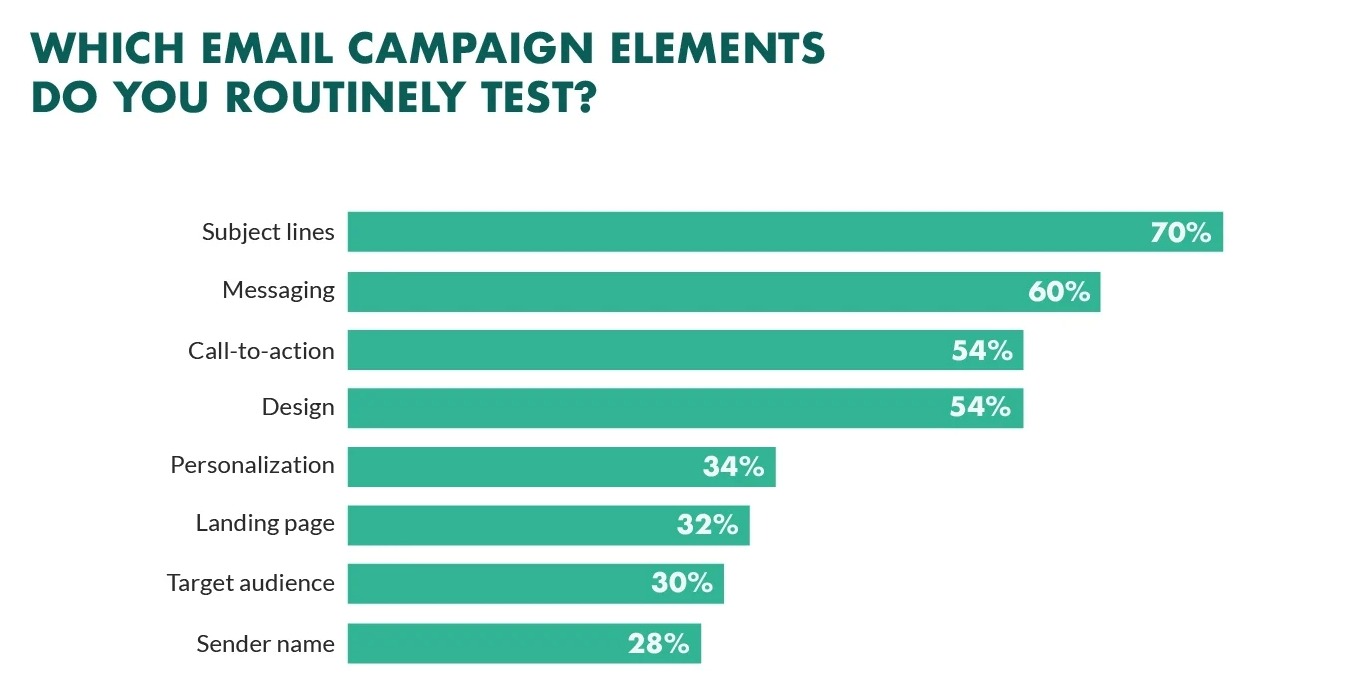11+ Email Testing Best Practices To Optimize Your Campaigns
You have to test, or you are just making uneducated guesses. A/B testing in email marketing is a recurring topic for all marketers since it can directly affect the result. That’s no big surprise because testing is one of the most powerful tactics to iterate and improve email campaigns.
If you don’t know, A/B testing email campaign can help you identify high-impact changes in your email design, landing pages, subject lines, and more. The gains here are basically enormous since each small improvement can lead to more opens, clickthroughs, and sales for your email campaigns.
To test your emails, all you need to do is create email variations for different groups of subscribers and then listen to their responses. The metrics will let you know their preference with your emails, which can then impact either in the short-term by sending the winning email to more of the audience or in the long-term by using that preference to improve future campaigns.
That sounds simple, right? To a degree, it actually is. Thanks to email service providers and new email marketing software rolling out functionality to make email testing much easier to execute than in the past. However, you can mess up your email testing without the right approach and come to the wrong conclusion or even undermine the campaign’s results completely.
Here are 11+ email testing best practices that will ensure you get the most out of the email testing efforts to avoid that unfortunate fate.
Email testing benefits
Before getting into the tips, let’s see why you should use email testing to have better results for your email campaigns. When split testing email marketing, you can:
-
Create more effective email campaigns based on the insights you gain from testing, resulting in more leads, engagement, and sales.
-
Base your email marketing campaigns’ decisions on data rather than guesswork or gut instinct. Remember, don’t make uneducated guesses.
-
Get more recipients to open your emails, click on your links, and ultimately convert into paying customers.
-
Recognize when your email marketing campaigns are working or not, based on subscribers’ actual response to actual email campaigns.
-
Minimize the risk of running new email campaigns by testing them with a small portion of subscribers before making permanent changes.
For all the reasons above, email testing must be an essential part of your email marketing strategy.
Before you start testing

Before you get started with email testing, you’ll need to d
groundwork like you’d do for any other type of marketing campaign.
First, you need to know your audience.
In other words, you need to understand the audience you’re marketing to. That means you’ll need to have buyer personas that can help you decide on email marketing content. You create buyer personas based on your customers’ age, location, education, gender, sources of information, pain points, and key challenges.
Secondly, you need to segment your email list.
It’s worth noting that your subscriber list doesn’t include a single homogeneous group. Your subscribers are likely to have different interests and are at various stages when they interact with you. Therefore, it makes sense to segment your subscriber list so you can send the right messages to the right audience group at the right. This will result in a higher open and click rate for your campaigns.
Thirdly, you need to create an email marketing campaign.
Having an email campaign that you can test is crucial to the testing process. That means you will need to:
-
Choose a properly formatted and mobile-friendly email template like the ones we have in our app AVADA Email Marketing.
-
Pay attention to branding, images, color, and fonts.
-
Make sure your email content is short and scannable
-
Create a call to action that makes recipients want to take action
Fourthly, you need to track your metrics.
You should understand your current metrics as a baseline to measure the success of your email campaign testing. That means you need to track key email marketing metrics such as:
-
Email open rates
-
Email clickthrough rates
-
Email deliverability
-
Leads and sales resulting from email campaigns
Fortunately, your email marketing service is most likely to automatically track data on opens, clicks, and bounce rates. Once you have this data or know how to measure them, you can get started with email testing ideas. The starting point for this is to have testing goals, but I will include that in the next section of email testing best practices.
11+ email testing best practices to optimize your campaigns

The most effective email marketers are constantly finding new ways to improve email strategies and never satisfied with the results.
However, email testing can take a lot of time and energy. It’s essential to perform mini behavioral experiments continuously to get the best results without tiring yourself out. So, consider yourself an email scientist and look at these email tests best make testing your email campaigns a little easier:
1. Make sure to have a valid testing goal
Creating a valid email testing goal is a crucial first step of email conversion optimization. Your email testing goal would also include:
-
How to observe what’s happening with your campaigns currently
-
How to speculate about possible reasons
-
How you’re going to fix or improve the situation
-
How to measure and see if the email campaign has worked or not
Here’s how an email testing goal can work:
First, you observed and noticed that your email clickthrough rate is declining over the last three emails. You believe it’s because you’ve been using the exact text for the call-to-action button, and subscribers haven’t noticed it.
A suggested fix is to try a variation of the email with different call-to-action button anchor texts. You will measure how it has worked if you can get the open rate back to previous levels with the following three emails.
For best results, create a goal for every email element you plan to test. This way, you will know if you are testing it right or not.
2. Isolate the test variable

In order to complete a successful email test, you should test only one variable at a time. Only by doing this can you truly determine how effective the test variable is.
Let’s assume you’re looking to increase the clickthrough rate. In your single email test, you try a few different designs for the call-to-action button and various images in the email body. Even if you succeed and see an increase in clicks, how can you know what change actually drove that behavior?
The short answer, you can’t, even with a clear goal and measurement system. Isolate variables for every email test you run so you can identify for sure which variables gave your email results.
3. Test simultaneously
Timing is everything for eCommerce email marketing. Throughout the year, your online store can experience seasonal highs and lows.
In order to account for any seasonal effect, changes to your product catalog or changes in your customer behavior, it is best to run your email tests in parallel with one another. With AVADA Email Marketing, you can split your audiences and deliver tests randomly to test more effectively.
4. Have statistically significant data to declare a winner

Email testing is much like science experiments, you want to make sure that the results you receive actually mean something before moving forward and implementing them into your email marketing strategy. In statistics, if you want your results to mean something, it must be “statistically significant.”
To determine the significance of stat, you use a p-value - which represents the chance that random probability or error can explain the result you find. A 5% or lower p-value is statistically significant. Depending on how many emails your email campaign sends, it can take a few weeks until your results achieve the preferable p-value of 5% or less.
5. Test against a controlled version
A controlled or default version is the original email you would have sent anyway, like when you aren’t testing anything. This will provide you with reliable baselines to compare your testing results with. The reason that having a controlled version is so important, is because you will always find confounding variables that you can’t control that impact your test’s validity.
For example, a confounding variable can be something like your email recipients being on vacation and have no internet access to receive your emails during your test. By testing against a controlled version, you have less confounding variables as possible and make your results more accurate.
A controlled email version will also be an easy variable to compare testing results against. Without a baseline to compare against, it becomes difficult to measure and analyze the actual result the test version has driven.
6. Focus your testing efforts on the most important elements
Sometimes just tiny tweaks to small elements can move the needle of the email performance for you, but it’s often wiser to focus your testing effort on key email elements, such as calls-to-action, subject lines, and images.
In addition to these elements, your automated emails also have other elements that are worth testing. In my recommendation, you should also test:
-
How quickly to send the following message after it’s triggered
-
Different trigger logic for automated sequences
-
The delay time between automated emails in a series
-
Whether to send a sequences of automated emails or not
-
Under what conditions your automated email series ends
-
Under what conditions you skip an automated email in a series
7. Choose a victory metric that aligns with the campaign’s goal
I mentioned setting a goal for testing, but choosing a victory metric for your email testing is also crucial. Where some marketers think subject lines can only affect the open rate, email content can only affect the clickthrough rate, and landing pages can only affect the conversion rate, the different stages of email interaction all work together because subscribers interact with them all together.
When you embrace this ideology, you realize that a subject line’s goal isn’t to generate opens. It’s to make openers convert. And similarly, the goal of your email content isn’t to get more clicks. It’s to generate more clickers who are likely to buy. So, after setting your testing goal, consider what the victory metric for your email campaigns will be, and take that as the ultimate achievement.
8. Segment your subscribers well

Just like controlling the changes that you make to email A and B, you also want to control which audience gets each version. Two test groups of your email campaign should share the same kinds of subscribers, whether you segment them by new subscribers, customers, or subscribers in a particular gender or geography, for instance.
Similarly, you want to ensure that testing both groups of recipients contain active subscribers who regularly engage with your emails. Otherwise, if the first email goes to a group of much more active subscribers than the group that got the second email, then the first email is much more likely to “win” for reasons that even have nothing to do with the testing variable inside it.
9. Use holdout groups when you can
For any email testing, consider how your subscribers would react if they don’t receive that email at all. Using a holdout group of subscribers who don’t receive the testing email is how to measure that effect.
Holdout groups are valuable for you to test automated emails. For example, if you’re testing the performance of a new cart abandonment email, you want to make sure that a small part of cart abandoners don’t receive the cart abandonment email at all. Doing that will let you know if your cart abandonment email annoys subscribers or disrupts their natural shopping behaviors.
A holdout group can be used to test any email you send to make sure that you are actually having a positive effect on the subscribers. Not all changes to email are good, and now with a holdout group you can know if that is true for your emails.
10. Test regularly and record the result
Email testing can get inefficient if you do it sporadically with an unfocused approach. To get the most out of your email tests, you need a plan - which is a testing schedule that can record:
-
Which emails you use to test each theory
-
The theories you want to confirm with your tests
-
The results of each email test and how they impact the future testing plans
Aim to do email testing in at least half of your segmented promotional emails, as brands get less competitive advantage when they do test less frequently than that. Similarly, brands can have a significant increase in success when they test their transactional and triggered emails once every 6 months.
A test plan is also essential because you’ll need to confirm the result of testing over a long period of time. Subscribers are often attracted to the new offer and content, so you need to run the same test two or three times to wring out any novelty effect and see the true impact of your email changes.
The more definitive a test’s success is, the longer you can wait to confirm the result again. But eventually, you still want to periodically reconfirm the result of every test at least once or twice - which is also why having a testing plan is critical.
11. Share the test results with your colleagues
Be sure to share your email testing insights with other teams doing web, social media, and ad. It is easy to understand because email marketing learnings can increase the chance of success for other channels as well.
Poor coordination across departments and channels is identified as one of the biggest challenges facing email marketers. So sharing your testing result is just a way for your brand to foster an omnichannel approach to marketing and your customer experience.
Learn more: Best Email Testing Tools You Should Try
Final advice
Just about every aspect of email marketing can be tested for optimization. You can get creative with your variables and think of new aspects to test every day. Take the subject line as an example. You already have several variables to test within that single aspect of an email, such as tone, length, mention of a promotion, different uses of the recipient’s name, and others.
As long as you keep testing and follow these email testing best practices, you can make your email campaigns even more effective and combine it with other marketing channels. Best of luck on testing with your emails. If you have any questions about email testing, share them in the comments.
New Posts

How To Set Up Google Analytics 4 For Your BigCommerce Store






